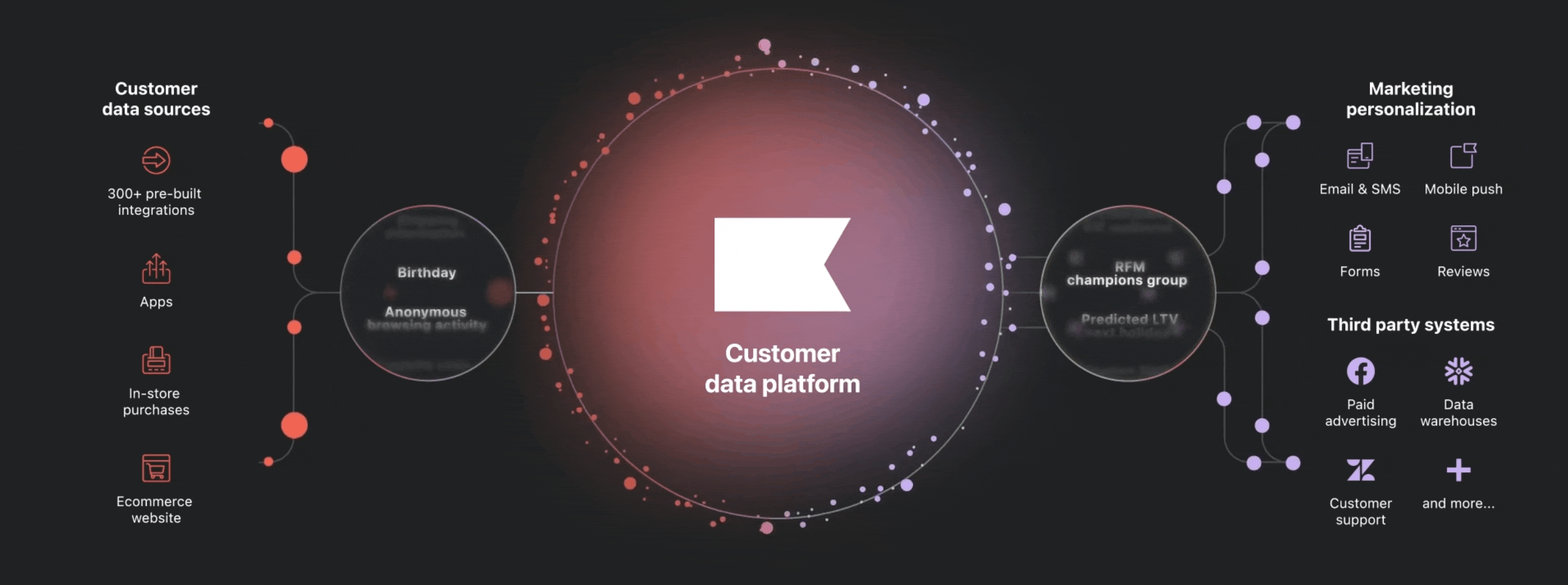An Introduction to CDPs in Ecommerce
A Customer Data Platform (CDP) offers unparalleled insight into customer behaviour, both on- and offline. This data enables you to craft hyper-personalised customer journeys and make data-driven decisions.
Written By
Mia Willmott

As an ecommerce retailer, you’ll know just how important customer data is to your business. However, with customer information often found across different, siloed systems, it can be difficult to leverage your data to effectively inform decisions and increase revenue.
Moreover, the data you are comparing between systems can have the same name but a different meaning. Thus, all data should be standardised to provide accurate reporting.
This is where a Customer Data Platform, or CDP, comes in.
In this article, we’ll provide an introduction to CDPs, how they work, and what benefits they can provide in ecommerce. We’ll also examine key considerations for choosing a CDP and take a look at why some CDP implementations fail.
What is a CDP?
A CDP is a software system that aggregates and unifies customer data from various sources into a coherent view of each individual customer. You could think of it as a single source of truth for understanding the data behind customer behaviour at scale.
By consolidating different datasets into one unified persona per customer, marketers, strategists, product owners and others gain insight into customer behaviour, preferences and needs – and can optimise products and experiences accordingly.
How does a CDP work?
A CDP collects, unifies and activates customer data. These three factors form the foundation of a CDP for ecommerce. Let’s break these down to better understand how a CDP works, before exploring why it’s a beneficial asset for commercial operations.
1. Data collection
A CDP collects customer data from various sources, such as website interactions, purchase history, email engagement, and social media activity. Data can be gathered in a variety of methods, from pre-built integrations and APIs, to Secure File Transfer Protocols (SFTPs), webhooks, Software Development Kits (SDKs) and more.
This data is collected in real-time and can include both structured and unstructured data, and originate from zero-, second- and third-party data categories. Data transformation is employed at this stage to ensure all information is presented consistently, regardless of its original source.
2. Data unification
A CDP unifies this data into single customer profiles. This is a complex process whereby data from different sources and categories is collated and organised to create a comprehensive view of individual customers, in accordance with their data security settings.
Advanced algorithms and machine learning are utilised to ensure the accuracy and integrity of customer profiles.
3. Data activation
Whilst collecting and unifying data are vital steps involved in a CDP, they aren’t the end goal. Rather, they are the means by which CDPs (and the teams utilising them) leverage this data.
With the unified customer profiles in place, a CDP can activate the data through two primary modes: insight and engagement. These can be either internal or external to the CDP itself.
Benefits of a CDP for ecommerce
Data should drive a brand’s ecommerce operations and decision-making. This is a frequently discussed topic, but can be hard to put into practice. The benefits of a CDP for ecommerce are similar to those provided by other data platforms, but where it differs is its ability to collate data from numerous sources, in different forms, and at scale.
Below is an outline of the benefits and opportunities this increased scale creates.
Improved customer segmentation and targeting
A CDP allows ecommerce businesses to segment their customer base according to various attributes, such as demographics, behaviour, and purchase history.
This enables more targeted and effective marketing campaigns, leading to higher conversion rates and customer satisfaction.
Personalised product recommendations and offers
By leveraging the rich customer data stored in a CDP, ecommerce businesses can deliver personalised product recommendations and offers to individual customers.
This level of personalisation enhances the shopping experience, increases average order value, and fosters customer loyalty.
Enables fast and agile decision-making
With all your data collated into a central place, you can observe and analyse this data faster. The knock-on effect of this is the ability to make data-informed decisions more frequently and be ready to adapt marketing efforts and ecommerce operations when required.
Efficiency and speed is also increased because marketing teams aren’t reliant on development support to gain access to accurate data.
Seamless omnichannel experiences
By unifying customer data across all touchpoints, including online and offline channels, ecommerce businesses can deliver consistent experiences to customers as they move across channels.
For example, if a user stops using an app for a smart watch, the product’s hardware may have stopped working. A re-engagement email flow could be used, suggesting a watch strap replacement, for example. Or, if someone has purchased a wearable tech product, but has not set up the adjacent app within 14 days, an automated flow could be triggered, offering installation help or advice.
Improved customer loyalty
Enhanced customer loyalty and retention are achieved by leveraging the unified customer data to deliver consistent, relevant, and timely communications across all channels. This fosters a deeper emotional connection between the brand and the customer, leading to increased brand advocacy and lifetime value.
CDP strategies
As you can see, integrating a CDP into your commerce tech stack could unlock significant opportunities to enhance your customer data, make smarter decisions, and provide more compelling customer experiences.
Let’s consider some of the different ways you can use a CDP in your business:
- If you sell your products via retail partners, as well as directly to end consumers, you could use a CDP to capture, interrogate and activate data from customers who haven’t bought from you directly. Data capture could take place during product warranty registration, or via a competition promoted on product packaging, for instance. This strategy will allow you to expand your owned audience, helping you learn more about your customers and enabling you to send targeted, automated marketing to an entire cohort.
- Similarly, brands with a B2B function could use a CDP to capture more customer data from wholesale sales – again giving your business a larger owned data pool.
- For brand groups looking to improve profitability and learn more about their customer cohort, a CDP could be used to transition consumers between brands without needing to reacquire them.
These are just a few examples of CDP strategies for ecommerce. We’d love to discuss these and other use cases with you – get in touch with our team if you have an idea you think could be valuable for your business.
Choosing a CDP
Much like any decision involving an ecommerce tech stack, there are a variety of factors to consider. Here are some that we recommend to help ensure you make the right decision.
Data integration capabilities
Ensure the CDP can integrate with your existing ecommerce platform, marketing tools, and other data sources. APIs are required to make these integrations, but a pre-built connector is not always a necessity.
Swanky has a dedicated integrations team that utilise Patchworks to connect Shopify with any other platform. This means you aren’t limited to pre-built API connections when choosing CDPs – or any technology.
Scalability and performance
The tech you’re using to power an ecommerce store should be able to grow and scale with you. In other words, your tech shouldn’t hinder your growth. For this reason, we recommend consolidating your tech stack periodically to avoid technical debt and improve efficiency.
Therefore, choosing a CDP that can handle the volume and velocity of your ecommerce data (both now, and for your next period of growth). It should be able to process large amounts of data in real-time without compromising performance.
Usability
Your chosen CDP should have an intuitive user interface (UI), allowing marketers and other non-technical users to easily consolidate and activate customer data for various use cases. With a good UI, team efficiency improves because development support is no longer required for marketing and user experience (UX) teams to have comprehensive data visibility.
Why do CDP implementations fail?
1. Rushing or overcomplicating implementation
New CDP users can run the risk of overcomplicating the initial implementation process. We would suggest starting with the marketing use cases and core business insights you wish to gain with the application of a CDP.
Once these goals are defined, consider which systems, platforms and processes are most important. As goals change and proficiency increases, you can iterate this process, steadily progressing the use of data to build understanding and drive engagement.
2. Lack of data governance
Data governance is a set of procedures to ensure data is secure, private, accurate, available and usable within an organisation.1
Effective data governance is vital for the successful implementation of a CDP and without robust, complete processes in place, CDPs cannot function correctly – or in compliance with regional legislation.
3. Not realising the full value of a CDP
When used correctly, a CDP should provide a wealth of ideas for strategic marketing activities that will improve your marketing, products and customer experience. However, all too often we witness CDPs not being used to their full potential, with retailers only leveraging their data reporting capabilities.
Acquiring in-depth training and understanding will help mitigate this, allowing a CDP to positively impact marketing, products and customer experience through correct application.
4. No defined measurements of success
When leveraging data from a CDP to inspire new strategic activities, we recommend defining what success looks like. Review timeframes should be outlined alongside these targets.
By doing this, you can allocate resources effectively and create a clear validation process.
For example, say you want to understand the correlation between online marketing and in-store revenue. You may choose to measure per day revenue change within two days of new campaign delivery, in order to validate (or invalidate) a link between these two variables.
A larger example, demonstrating the breadth of opportunities with a CDP for a food and beverage brand, could look like this. Imagine you want to understand when customers shop in-store, increasing the likelihood that their recurring subscription would overfill their fridge. You could conduct an experiment prompting users who shop in-store to skip this month’s subscription in case their fridge is full – with the aim of reducing churn rates and increase customer retention. Success would be measured as the difference in Customer Lifetime Value (CLV) between a control and a challenger group.
Moreover, this example demonstrates how A/B testing can be utilised across a business to optimise commercial practice, tech stack and customer experience.
Klaviyo CDP

Animation demonstrating functionality of Klaviyo’s CDP.
Klaviyo is well known for its email and SMS marketing capabilities. However, this is only a small part of the company’s service offering. This SaaS company has been leveraging data to drive growth since its inception and released its proprietary CDP platform in August 2023.
Built to empower retailers with deeper insights and better data, Klaviyo CDP extends the power of Klaviyo with:
- advanced audience-level reporting and predictive modelling;
- dynamically personalised web experiences;
- robust data transformation for accurate segmentation and reporting;
- expanded webhooks for real-time data syncs; and
- much more.
Given Klaviyo’s experience with data, ecommerce and Shopify, we’re excited to see how Shopify Plus brands will integrate this product into their tech stacks. As an official Klaviyo partner agency, we can provide expert support in the implementation and management of Klaviyo CDP, ensuring seamless integration with the rest of your digital toolbox.
Using a CDP to support ecommerce growth
As a leading Shopify Plus agency, Swanky knows how to craft bespoke ecommerce tech stacks to power online growth. If you’re considering implementing a CDP, or looking to review your tech stack, start a conversation with our experts today.
For reference:
- https://cloud.google.com/learn/what-is-data-governance
- Customer Data Platforms, Klaviyo Special Edition, Dan Sullivan.

